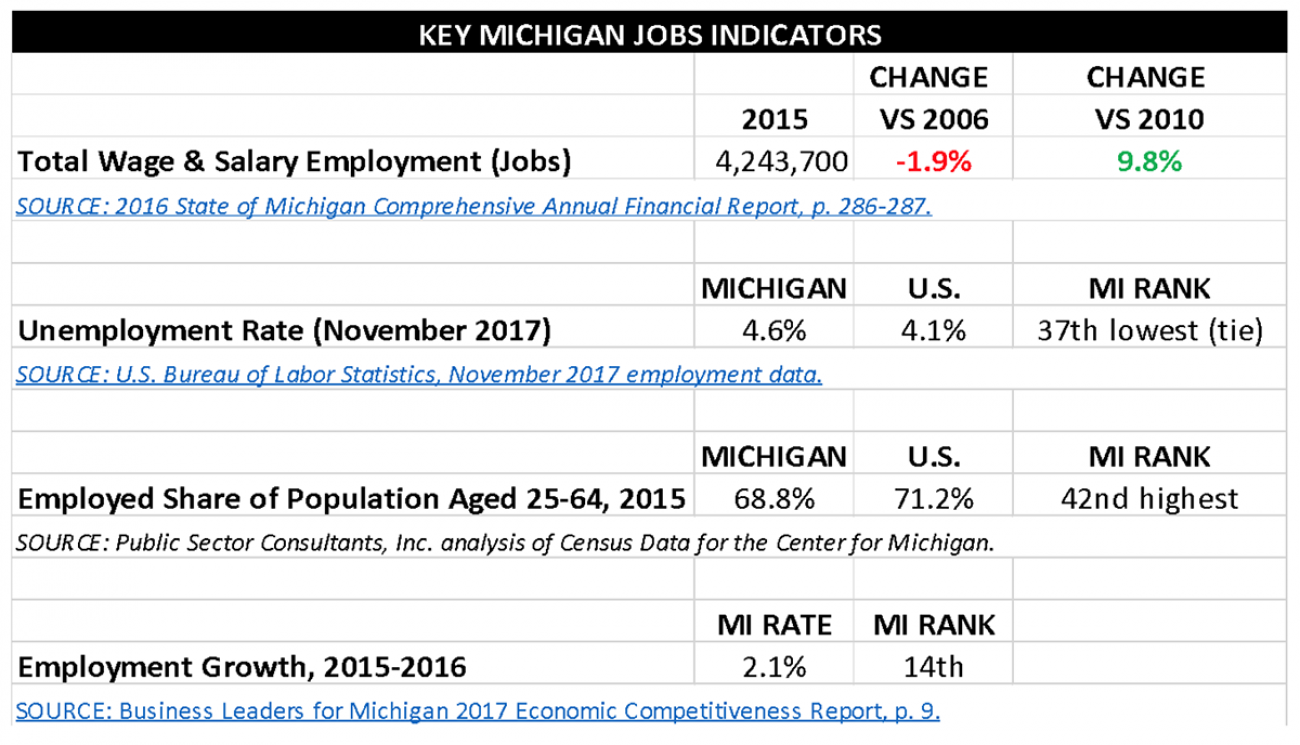Demand for Michigan workers is very high, but many have given up looking

Michigan paydays aren’t what they used to be. Many paychecks are smaller than a generation ago. There are fewer paychecks, too. Still, the current climate for workers is measurably better than the depths of the Great Recession in 2009-10. Looking ahead, the path to prosperity looks rocky for many future workers.
Pulling Out of the Great Recession Tailspin
As anyone who lived and worked through it remembers, Michigan lost hundreds of thousands of jobs in the Great Recession. The glass half-empty view… At the end of 2015, total Michigan employment was still 2 percent lower than in 2006. The glass half-full view… After several years of recovery, Michigan had 9.8 percent more jobs in 2015 than in 2010.
Phil Power column: Amazon to Michigan: Fix your schools!
Michigan has experienced eight consecutive years of payroll growth and better than the national average gains the last few years. But the recovery has been uneven, and, unlike previous recoveries, didn’t include a full return to widespread, high-paying manufacturing employment. As of the beginning of 2018, Michigan’s unemployment rate is below 5 percent, near historical lows, and largely mirrors the national rate. But that raw number masks the fact that a wide range of Michigan adults simply stopped looking for work. Michigan’s adult workforce participation rate ranks near the bottom nationally.

Jobs Bright Spots
Michigan has the highest percentage of workers engaged in engineering work – good paying jobs that will be in demand as manufacturing continues to move to advanced materials and increasing automation. It has large research universities churning highly educated graduates. And Michigan is still the home to one of the largest industries – autos – in the country.
The western side of the state has done very well in terms of recent job growth. The jobless rate in Kent, Ottawa and Kalamazoo counties fell to near-historical low levels in 2017 and employers have said their biggest problem is finding workers.
Related economic coverage from our 2018 Michigan Issue Guide
- Michigan business climate improves, but educated workforce is shrinking
- Michigan income growth hindered by lack of college graduates
- Business incentives cost Michigan millions, and it’s uncertain they work
Statewide, economists project robust near-term job growth in professional and business services (37,000 more jobs) and construction (11,000 more jobs) thru 2019.
In addition, the education and health services sector has added 60,000 jobs since 2008. But, in some cases (such as lower-level health-care service jobs for an aging population) growing job sectors feature considerably lower wages than Michigan’s past manufacturing glory.
Stubborn Jobs Hurdles
The highest-paying jobs of the future almost universally require advanced training beyond high school. High-tech, growing industries of the 21st century also require deep talent pools filled by college grads. Herein lies one of the state’s problems. In Michigan, 28.3 percent of adults have a college degree. That’s well below the national average (31.3 percent). Michigan ranks 36th nationally in terms of educational attainment. Adults with a college degree can make $1 million more over a lifetime of earnings, compared to someone with a high school diploma and they experience far lower levels of unemployment. College grads’ jobless rate in 2015 was 2.7 percent, compared to 8.6 percent for those with just a high school diploma.
Another challenge is the state’s aging workforce. One in 5 workers is over 55 and far closer to retirement than a graduation ceremony. That impediment also creates opportunity: in a well-paying field like tool-and-die work, the loss of so many older specialists is creating demand. Nearly three-quarters of all tool-and-die workers are over 45.
As some regions and industries have experienced labor shortages in recent years, the problem is compounded by significant numbers of applicants who failed drug tests.
Finally, rural areas of Michigan face their own set of challenges: shrinking and aging populations, loss of young talent, empty storefronts, and a loss of business enterprises.
Chasing Opportunities
Given the state’s rattled labor force, it’s obvious why Michigan sought to secure the second Amazon headquarters and the prospect of 50,000 new jobs. State leaders in 2017 passed sweeping new incentives aimed at attracting high-tech, jobs-producing firms like Amazon and Foxconn (which builds Apple’s iPhone, but ultimately opted for Wisconsin for new U.S. operations).
Michigan has also approved new opportunities for skilled trades training and new rules requiring high school counselors to get more skills to help students make college and career decisions.
In a proposal to help land Amazon, Gov. Rick Snyder proposed spending tens of millions of dollars on information technology (IT) scholarships and improved IT programs high schools and colleges. It’s a tacit acknowledgment that what companies like Amazon need is not currently found in Michigan’s labor force. Snyder has been talking about a “Marshall Plan for Talent,” a reference to the huge amount of money spent on rebuilding Europe after World War II.
Without more advanced training, Michigan could fall behind other nations in growing the high-tech manufacturing of the future.
KEEP DIGGING: MORE INFORMATION ON MICHIGAN JOBS & LABOR FORCE
- University of Michigan: State economy poised to withstand NAFTA withdrawal
- Michigan League for Public Policy: Michigan’s aging workforce
- Center for Automotive Research: New Materials/New Skills for the Trades
- Bridge Magazine: Booming Again: West Michigan’s Economy is on a Roll
- Bridge Magazine: Michigan’s Stumbling Middle Class
- Bridge Magazine: Death of Entrepreneurship
- Bridge Magazine: Northern Michigan’s 'Disability Belt' now rivals the Deep South and Appalachia
Explore the Facts & Issues Guide:
At A Glance
Slideshows…
Education & Talent
- K-12 Student Performance: Michigan's K-12 performance dropping at alarming rate
- School Reform: Many Michigan K-12 reform ideas are jumbled, broad, or wildly expensive
- Early Childhood: Michigan preschool funding has improved, but child care still unaffordable
- Higher Ed: College funding cuts in Michigan have led to fewer students, greater debt
Economy & Prosperity
- Economy: Michigan business climate improves, but educated workforce is shrinking
- Jobs & Labor: Demand for Michigan workers is very high, but many have given up looking
- Incomes: Michigan income growth hindered by lack of college graduates
- Business: Business incentives cost Michigan millions, and it’s uncertain they work
Quality of Life
- Public Health: Michigan's adverse health trends track along racal, poverty lines
- Health Care: Health care in rural Michigan communities suffering, despite Obamacare
- Safety Net: $1B of Michigan’s welfare money goes to college students who aren’t poor
- Water Issues: Michigan's Great Lakes are good, but water concerns include lead and Line 5
- Lands & Energy: Michigan battling 22 invasive forest species, high electric bills
- Michigan Tourism: Does state make $8.33 for every $1 spent on Pure Michigan campaign?
- Infrastructure: Michigan needs $4B more per year for infrastructure, but how to pay for it?
- Cities: In Michigan, more than 150 communities are financially distressed
- Rural Michigan: Limited Internet in rural Michigan depresses student, business opportunity
- Public Safety: Michigan pays 18% less per citizen than nat'l average for public safety
Government & Reform
- Michigan Taxes: Michigan gives more tax breaks than it collects for schools, government
- State Spending: Big government? Michigan's state, local workforce 2nd smallest in nation
- Ballot Issues: 2018 Michigan ballot initiatives may decide marijuana, gerrymandering
- Gov't Reform: Despite low trust of gov't, Michigan legislators have done little to change
Who We Are & The Facts on Our Facts
See what new members are saying about why they donated to Bridge Michigan:
- “In order for this information to be accurate and unbiased it must be underwritten by its readers, not by special interests.” - Larry S.
- “Not many other media sources report on the topics Bridge does.” - Susan B.
- “Your journalism is outstanding and rare these days.” - Mark S.
If you want to ensure the future of nonpartisan, nonprofit Michigan journalism, please become a member today. You, too, will be asked why you donated and maybe we'll feature your quote next time!

